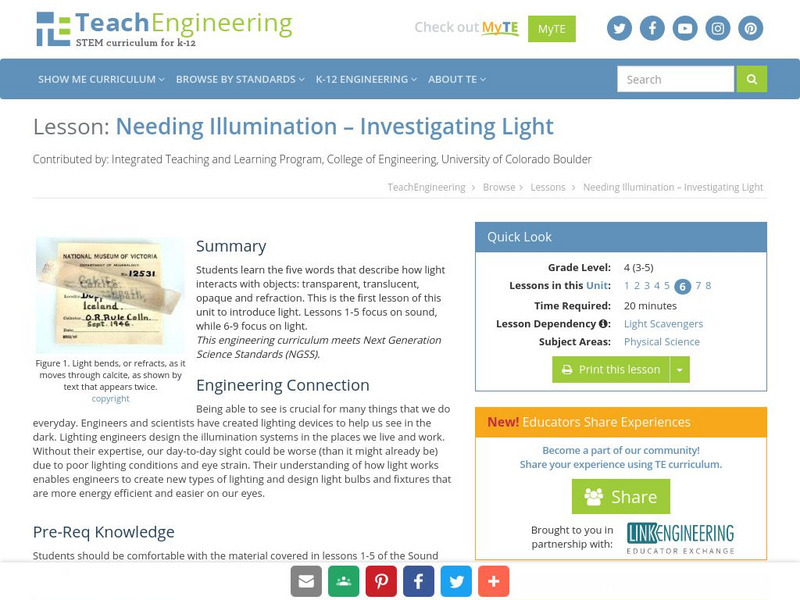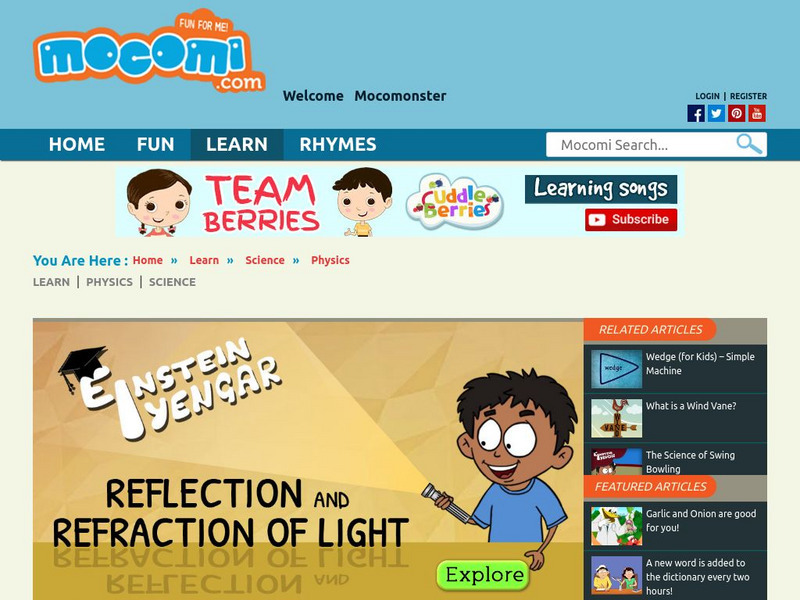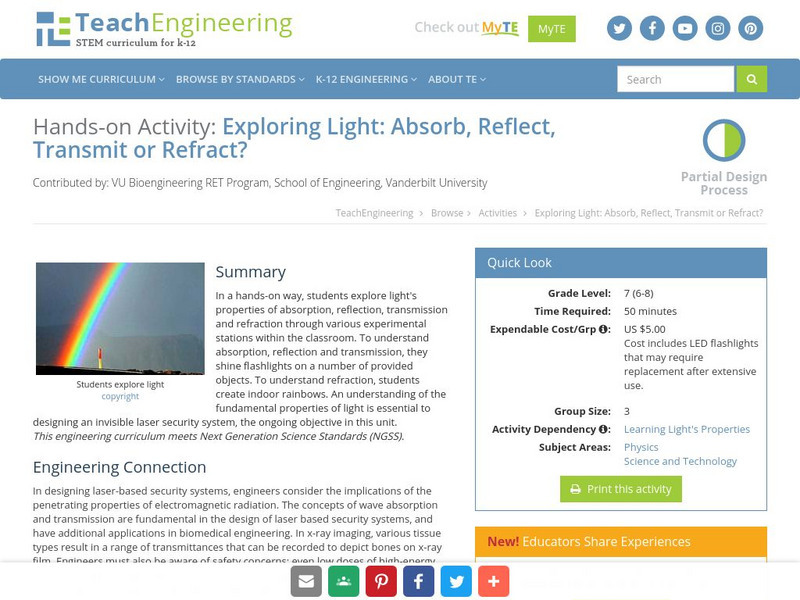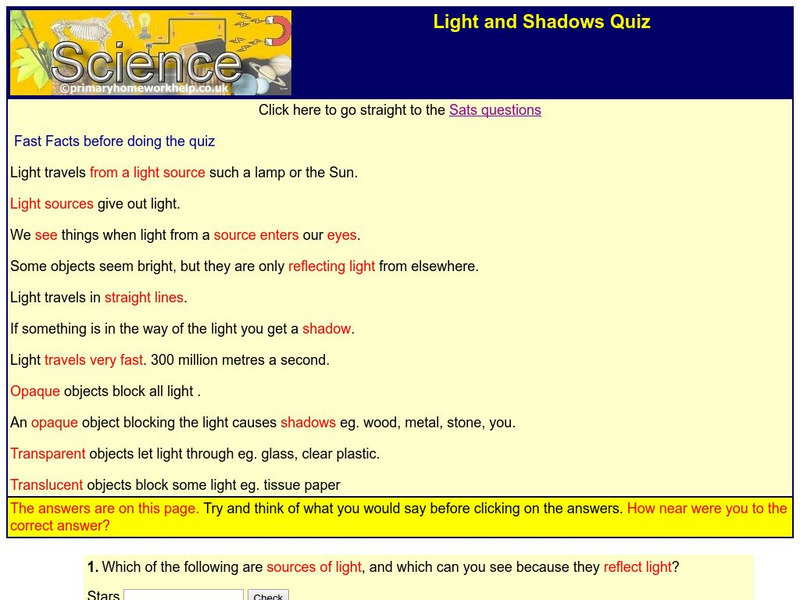TeachEngineering
Teach Engineering: Needing Illumination: Investigating Light
This is the first lesson plan of this unit to introduce light. In this lesson plan, students learn the five words that describe how light interacts with objects: "transparent," "translucent," "opaque," "reflection" and "refraction."
BBC
Bbc: Gcse Bitesize: Why Do Scientists Think That Light and Sound Are Waves?
Light travels as transverse waves and can travel through a vacuum. Sound travels as longitudinal waves and needs to travel through a solid, liquid or gas. Read about the properties of light and of sound, and learn the differences between...
Physics Classroom
The Physics Classroom: The Law of Reflection
The law of reflection is discussed and explained, accompanied by an animation depicting this law. Includes a list of links to detailed information about certain types of reflections.
Mocomi & Anibrain Digital Technologies
Mocomi: Reflection and Refraction of Light
What happens when a ball is thrown against a wall? This narrative illustrates how light is reflected or refracted in different circumstances.
Physics Classroom
The Physics Classroom: Reflection and Ray Model of Light: Ray Diagrams Concave
In this physics tutorial, students investigate the method for drawing ray diagrams for objects placed at various locations in front of a concave mirror.
Physics Classroom
The Physics Classroom: Reflection and Ray Model of Light: Spherical Aberration
An illustrated physics tutorial which explains the spherical aberration, an intrinsic defect with any mirror that takes on the shape of a sphere.
Physics Classroom
The Physics Classroom: Reflection/ray Model of Light: Ray Diagrams Convex
Students learn two rules of reflection as it has to do with convex mirrors. These two rules will greatly simplify the task of determining the image locations for objects placed in front of convex mirrors.
Physics Classroom
The Physics Classroom: Reflection/ray Model of Light: The Mirror Equation Convex
While a ray diagram may help one determine the approximate location and size of the image, it will not provide numerical information about image distance and image size. To obtain this, students are introduced to the Mirror Equation and...
Physics Classroom
The Physics Classroom: Refraction and the Ray Model of Light: Rainbow Formation
Understand the physics behind Roy G. Biv, and how rainbows are formed by drawing upon our understanding of refraction, internal reflection, and dispersion.
Physics Classroom
The Physics Classroom: Reflection and the Ray Model of Light: Ray Diagrams
This illustrated physics tutorial serves as a step-by-step guide to drawing ray diagrams. It includes an opportunity for students to practice and check their answers.
Physics Classroom
The Physics Classroom: Reflection and Ray Model of Light: Image Characteristics
Through illustrated examples and interactive practice problems, students learn about real and virtual images.
Physics Classroom
The Physics Classroom: Reflection and Ray Model of Light: Why an Image Is Formed
This illustrated physics tutorial uses animations to attempt to explain to students why images appear.
TeachEngineering
Teach Engineering: The Energy of Light
In this introduction to light energy, students learn about reflection and refraction as they learn that light travels in wave form. Through hands-on activities, they see how prisms, magnifying glasses and polarized lenses work. They also...
Physics Classroom
The Physics Classroom: Light Waves and Color: Polarization
Through illustrated practice problems and video clips, students learn about polarization of light.
Physics Classroom
The Physics Classroom: Light Waves and Color: Thin Film Interference
Students investigate an example of interference that provides further evidence in support of the wavelike behavior of light.
University of Colorado
University of Colorado: Ph Et Interactive Simulations: Bending Light
Manipulate variables and measure angles as light is refracted in this interactive simulation.
University of New South Wales (Australia)
University of New South Wales: School of Physics: Physclips: Geometrical Optics
Physiclips thoroughly presents geometrical optics concepts like rays, refraction, Snell's law, total internal reflection, dispersion, mirrors, and lenses with animations and film clips.
Physics Classroom
The Physics Classroom: Reflection/light Ray Model: Specular/diffuse Reflection
A series of incident rays and their corresponding reflected rays are depicted in the diagrams in this tutorial. Each ray strikes a surface with a different orientation; yet each ray reflects in accordance with the law of reflection.
Khan Academy
Khan Academy: Reflection and Refraction Questions
This is a 10-question exercise/quiz pertaining to reflection and refraction.
CK-12 Foundation
Ck 12: Physical Science: Refraction
[Free Registration/Login may be required to access all resource tools.] Refraction of light in matter and how light changes its speed and angle of refraction according to the type of medium it is travelling through.
TeachEngineering
Teach Engineering: Exploring Light: Absorb, Reflect, Transmit or Refract?
In a hands-on way, students explore light's properties of absorption, reflection, transmission and refraction through various experimental stations within the classroom. To understand absorption, reflection and transmission, they shine...
Physics Classroom
The Physics Classroom: Light Waves/color: Absorption, Reflection, Transmission
In this physics classroom, students learn how and why light of certain frequencies can be selectively absorbed, reflected or transmitted.
Project Britain
Primary Homework Help: Light and Shadows Quiz
This resource provides information about light and shadows. In addition, there is a short quiz that can be taken.
South Carolina Educational Television
Know It All Media: Light and Color
Why do we see certain colors? This interactive animation demonstrates the concept of the visible spectrum, and how we see the different colors of the rainbow.











